Villa of the Mosaics in Negrar, the first part of the excavations ends: it will become an archaeological park
The first part of the excavations carried out at the Villa of the Mosaics in Negrar della Valpolicella, the site where a splendid mosaic floor was discovered in 2020, has ended. Actually, the events related to the mosaics discovered in the hamlet Villa of the municipality of Negrar, and in particular in the Cortesele farm, go back many years. As far back as 1885, in fact, excavations by the Superintendency uncovered part of the residential sector of a Roman villa datable to the late imperial age (late 3rd-4th century AD), and since then other finds were not slow in coming. However, it was only in 2020 that, thanks to the first ministerial funding, the floor mosaics discovered in 1922 by excavations conducted by archaeologist Tina Campanile were identified and brought to light.
The stratigraphic excavations conducted since spring 2021 have confirmed that the villa is a rich and elegant “peristyle” dwelling, covering 3,000 square meters and organized around a vast central space, an inner courtyard or garden of about 400 square meters bordered by a colonnaded portico, with architectural and decorative features comparable to the highest level examples of the coeval residences of the Roman aristocracy. The new excavations brought to light new rooms (not identified by Tina Campanile in the 1920s) in the southern sector, as well as new portions of previously unknown mosaic: in particular, parts of the mosaic floor of the eastern sector were discovered. The northern sector, which is located on a raised terrace, is reached via a flight of steps: this is a decidedly rich area of the villa, where there were several rooms used as thermal spaces, namely the dressing room, theapodyterium (the entrance to the baths), the frigidarium and the calidarium, that is, the two rooms where cold and hot baths were taken, respectively.
The research was carried out under the technical direction of Alberto Manicardi of the SAP - Archaeological Society and with the contribution of the area’s owner, Azienda Agricola Benedetti Adriano “La Villa” owned by Matteo and Simone Benedetti. A formalized agreement with the Franchini Agricultural Society will allow the resumption, as of September 1, of archaeological research in the northwest sector, where investigations conducted earlier identified the presence of other structures. By the end of the year, Verona Superintendent Vincenzo Tinè announced at a press conference, stratigraphic excavations will be completed. Scholars will then try to better understand the succession of the different building phases of the complex (the stratigraphic sequence of the settlement’s earlier structures, of which evidence has emerged during excavation, is still being studied, as well as well as evidence of abandonment and despoliation in the late ancient-medieval period, some of which had already been identified by Tina Campanile anyway, and of reuse again in the medieval period, when the villa was by then buried and the area was put to agricultural use).
Now the musealization of the Villa, planned for 2022, is being studied: the Villa of the Mosaics will become, in essence, an archaeological park. Getting there will require the construction of a roof (which will be environmentally friendly and integrated into the landscape) and, of course, a museum tour with educational value, for which multimedia apparatus is also planned.
 |
| Villa of the Mosaics in Negrar, the first part of the excavations ends: it will become an archaeological park |
Warning: the translation into English of the original Italian article was created using automatic tools. We undertake to review all articles, but we do not guarantee the total absence of inaccuracies in the translation due to the program. You can find the original by clicking on the ITA button. If you find any mistake,please contact us.




























